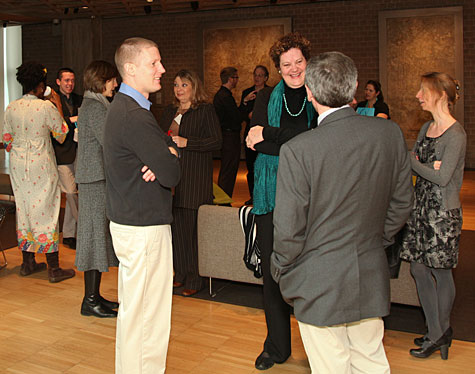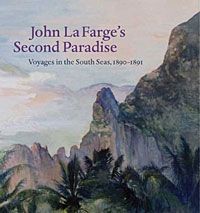
Elizabeth C. Childs, PhD, chair and associate professor of Art History and Archaeology (center) discusses the work of American painter John La Farge with WUSTL doctoral candidate Matthew Bailey (left) and Calvin Brown, associate curator of Prints and Drawings at the Princeton University Art Museum. The three were part of a small study group organized last fall by Princeton and the Yale University Art Gallery. Photo courtesy of Yale University Art Gallery.
In 1890, the American painter John La Farge (1835-1910) embarked on a yearlong journey through the islands of the South Pacific. Just months later, Paul Gauguin (1848-1903) began his own Polynesian odyssey. Though the two artists never met, their paths nearly crossed in Tahiti, with Gauguin arriving a mere four days after La Farge departed.
So it is perhaps only fitting that, last fall, a group of five graduate and undergraduate students from the Department of Art History and Archaeology in Arts & Sciences set out on their own mission of travel, visiting a pair of East Coast exhibitions that focused on works by the two artists.
Led by Elizabeth C. Childs, PhD, chair and associate professor of art history and archaeology, the students were part of a small study group organized by the Yale University Art Gallery and the Princeton University Art Museum. The two institutions were hosts, respectively, to John La Farge’s Second Paradise: Voyages in the South Seas, 1890-91 (Oct. 19-Jan. 2) and Gauguin’s Paradise Remembered: The Noa Noa Prints (Sept. 25-Jan. 2).
“It was a mobile symposium,” says Childs, an authority on Gauguin who also has written about La Farge and Colonial Tahiti. She explains that the study group — formally titled “Paul Gauguin and John La Farge in the South Pacific: Two Fin-de-Siècle Artists in Paradise” — included perhaps 30 invitees, among them internationally known authors, scholars and curators.
“This has become something of a trend in the museum world,” Childs says. Rather than sprawling — and expensive — symposiums, institutions are increasingly hosting smaller, more tightly focused discussions. “The idea is to bring together in one room the 10 or 15 top people in the world on a given subject, and then to see what happens.”
The trip to Yale and Princeton was in many ways an outgrowth of Childs’ own work on Gauguin and La Farge. Last October, she presented Yale’s 2010 Martin A. Ryerson Lecture, speaking on the topic of “Networking the Islands: Tourism and Exotic Quest in the South Seas Voyages of John La Farge.”
 In addition, Childs contributed two essays to the Second Paradise catalog. The first of these situates La Farge and his traveling companion — the famous historian and author Henry Adams — within a series of broader contexts: American and European imperialist expansion; the emergence of elite tourism practices; and the rich history of representation of the South Pacific as a sort of earthly paradise.
In addition, Childs contributed two essays to the Second Paradise catalog. The first of these situates La Farge and his traveling companion — the famous historian and author Henry Adams — within a series of broader contexts: American and European imperialist expansion; the emergence of elite tourism practices; and the rich history of representation of the South Pacific as a sort of earthly paradise.
Childs’ second essay — the first in-depth comparison of La Farge and Gauguin — explores the artists’ common ground in exoticist themes and nostalgic practices, but also reveals telling differences in their respective experiences of Tahiti as a locus of artistic inspiration and regeneration.
And so on Nov. 5, as the study group gathered in the Yale galleries — amidst dozens of watercolors, sketches and oil paintings by La Farge — it was Childs who kicked things off, moderating a comparison between Gauguin’s signature modernist primitivism and La Farge’s more aesthetically conservative style of classicized exoticism.
Childs was followed by Alastair Wright of Oxford, who led a conversation about reproduction and aesthetic strategy. Next up was Linda Goddard of the University of St. Andrews in Scotland, who compared the two artists’ writings and their audiences.
Other presenters included Henry Adams of Case Western Reserve University, who examined issues relating to the exhibition and criticism of works by La Farge and Gauguin in turn-of-the-century New York and Paris; and Yale curator Lisa Hodermarsky, who compared the artists’ modes of visualizing nostalgia for the ever-elusive, mythical paradise of the South Seas.
“There was a wonderful range of individuals and a really good group dynamic,” says Jennifer Padgett, a first-year graduate student in art history who also took part in Childs’ fall seminar, “Paul Gauguin in Context.”
“Many participants were scholars who had worked on either La Farge or Gauguin — or in some cases both — throughout their careers,” Padgett continues. “Others were students, or had just recently received their doctorates. The discussion was very open, very informal. Everyone had a chance to be heard.”
That evening, participants boarded a chartered bus and headed south down I-95 toward Princeton. The next day, they gathered again and resumed the conversation — this time surrounded by a stunning suite of Gauguin woodcuts.
“On both study days, we sat in the brilliantly curated galleries in front of original works of art and participated in lively and fascinating discussions,” says Aliya Reich, also a first-year art history graduate student.
Yet in many ways, Reich adds, the study group was most memorable for its impromptu moments and collegial atmosphere.
“Perhaps the most fun part was the bus trip,” Reich says. “To pass time on the three-hour trip, we played ‘20 Questions’ about works of art, which then developed into ‘Art Charades,’ and involved almost the entire bus. Seeing people whose scholarship I deeply respect in such a casual, relaxed atmosphere was a totally unique and enjoyable experience.”
Indeed, the entire experience was such a success that the Department of Art History and Archaeology recently launched an endowed fund to underwrite similar trips in the future.
“Starting next fall, we are establishing a regular travel seminar each year within the department’s offerings,” Childs says. “The idea is to provide faculty, in rotation, with the opportunity to travel with students to relevant museum exhibitions and collections, as a kind of a capstone experience in the advanced seminars. The trips will start off within the United States, but over time, we hope to be able to send some seminars on international field trips, incorporating a brief study-abroad experience into the semester’s work.
“In the end, within the discipline of art history, there is simply no substitute for studying works of art firsthand with the experts,” Childs says. “Offering this kind of focused training is the sort of teaching in which our faculty really excels.”
Comments and respectful dialogue are encouraged, but content will be moderated. Please, no personal attacks, obscenity or profanity, selling of commercial products, or endorsements of political candidates or positions. We reserve the right to remove any inappropriate comments. We also cannot address individual medical concerns or provide medical advice in this forum.